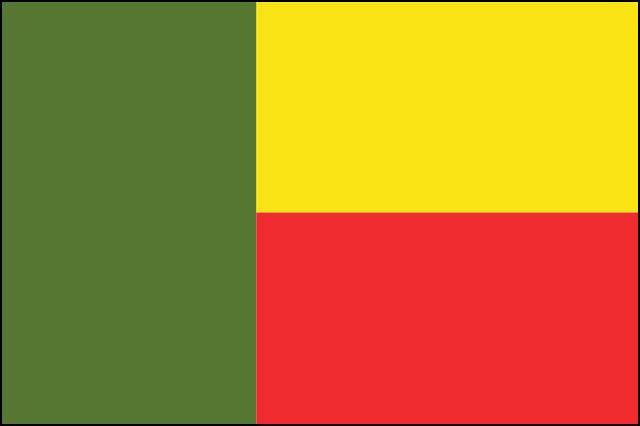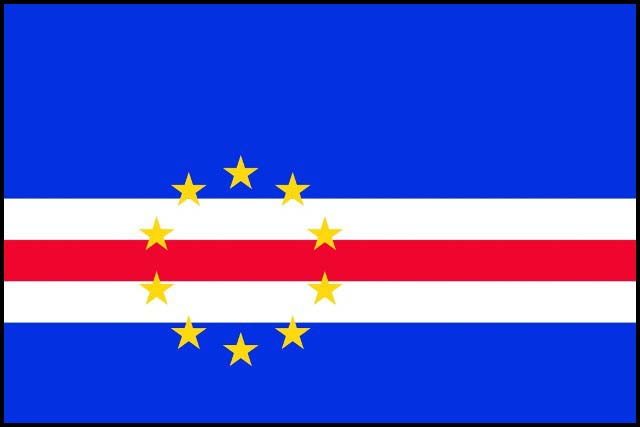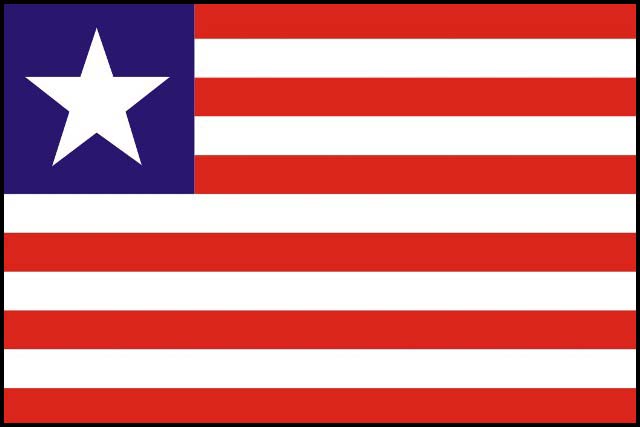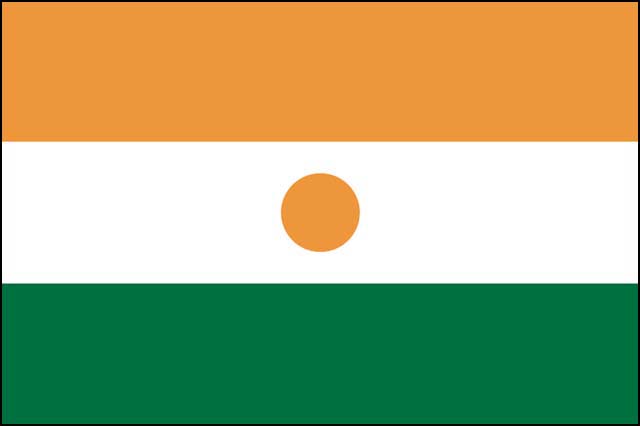Liberia
Overview of the country
Liberia is a Sub-Saharan nation in West Africa located at 6 °N, 9 °W. It is bordered by Sierra Leone to its northwest, Guinea to its north, Ivory Coast to its east, and the Atlantic Ocean to its southwest. It covers an area of 111,369 square kilometres (43,000 sq mi) of which 96,300 square kilometres (37,190 sq mi) is land and 15,000 square kilometres (5,810 sq mi) is water and has a population of 4,511,000
English is the official language, but over 20 indigenous languages are spoken, representing the numerous ethnic groups who make up more than 95% of the population. The country's capital and largest city is Monrovia.
Liberia was the first African republic to proclaim its independence and is Africa's first and oldest modern republic. It retained its independence during the Scramble for Africa. During World War II, Liberia supported the United States war efforts against Germany and in turn, the U.S. invested in considerable infrastructure in Liberia to help its war effort, which also aided the country in modernizing and improving its major air transportation facilities. In addition, President William Tubman encouraged economic changes. Internationally, Liberia was a founding member of the League of Nations, United Nations, and the Organisation of African Unity.
In 1980 political tensions from the rule of William R. Tolbert resulted in a military coup during which Tolbert was killed, marking the beginning of years-long political instability. Five years of military rule by the People's Redemption Council and five years of civilian rule by the National Democratic Party of Liberia were followed by the First and Second Liberian Civil Wars.
These resulted in the deaths of 250,000 people (about 8% of the population) and the displacement of many more, and shrank Liberia's economy by 90%. A peace agreement in 2003 led to democratic elections in 2005, in which Ellen Johnson Sirleaf was elected President, making history as the first female president in the continent. National infrastructure and basic social services were severely affected by the conflicts, with 83% of the population now living below the international poverty line.
Natural resources
Natural resources that are found in Liberia include Iron ore, timber, diamonds, gold and hydropower.
Land use and agriculture
arable land: 5.3%
permanent crops: 2.1%
permanent pastures: 20.7%
forest: 44.6%
other: 27.3% (2019)
Irrigated land
600,000 hectares of low land is in Liberia and 5% of the 600,000 hectares was developed as of 2019. About 30,000 square kilometres of Liberia's land was irrigated as of 2019.
Demographic of Liberia
Population, 4,511,000 (48.9% male and 51.1% female). Administrative division of Liberia: 72 electoral Districts and 15 counties.
Political, economic and social context of the country
-
Political context
The government of Liberia, modelled on the government of the United States, is a unitary constitutional republic and representative democracy as established by the Constitution. The government has three co-equal branches of government: the executive, headed by the president; the legislative, consisting of the bicameral Legislature of Liberia; and the judicial, consisting of the Supreme Court and several lower courts.
The president serves as head of government, head of state, and the commander-in-chief of the Armed Forces of Liberia. Among the president's other duties are to sign or veto legislative bills, grant pardons, and appoint Cabinet members, judges, and other public officials. Together with the vice president, the president is elected to a six-year term by majority vote in a two-round system and can serve up to two terms in office.
The Legislature is composed of the Senate and the House of Representatives. The House, led by a speaker, has 73 members apportioned among the 15 counties on the basis of the national census, with each county receiving a minimum of two members. Each House member represents an electoral district within a county as drawn by the National Elections Commission and is elected by a plurality of the popular vote of their district into a six-year term. The Senate is made up of two senators from each county for a total of 30 senators. Senators serve nine-year terms and are elected at-large by a plurality of the popular vote. The vice president serves as the President of the Senate, with a President pro tempore serving in their absence.
Liberia's highest judicial authority is the Supreme Court, made up of five members and headed by the Chief Justice of Liberia. Members are nominated to the court by the president and are confirmed by the Senate, serving until the age of 70. The judiciary is further divided into circuit and speciality courts, magistrate courts and justices of the peace. The judicial system is a blend of common law, based on Anglo-American law, and customary law. An informal system of traditional courts still exists within the rural areas of the country, with trial by ordeal remaining common despite being officially outlawed.
From 1877 to 1980 the government was dominated by the True Whig Party. Today over 20 political parties are registered in the country, based largely around personalities and ethnic groups. Most parties suffer from poor organizational capacity. The 2005 elections marked the first time that the president's party did not gain most seats in the Legislature
The administration of President George M. Weah clocked two years in office in January 2020 and will be taking stock of its deliverables in terms of social services and fulfilling campaign promises to the people of Liberia and what to achieve for the remaining four years.
The government put into place its Pro-Poor Agenda for Prosperity and Development (PAPD) at the latter part of the first year. The PAPD is guided by four pillars focusing on empowering Liberians through education, health, youth development and social protection, enabling private sector-led economic growth, supporting a peaceful society, and creating an inclusive and accountable public sector.
During the period under review, the country’s economy was challenged with rising inflation as a result of significant depreciation of the Liberian dollar against the United States dollar and other factors. This hampered the Government’s ability to fully deliver services and meet other obligations. Consequently, the Government is working with its development partners to help it tackle the economic glitches, while instituting measures to promote growth and development, critical for sustaining peace and stability. Following the highly contested 2017 Presidential and Legislative Elections that ushered in the George Weah-led administration into office, Liberia is bracing itself for the Senatorial Mid-Term Elections in 2020. The tenure of 15 out of 30 senators will be expiring and those seeking re-election will have to face the electorates. The Legislature has passed a bill for a national referendum to reduce the tenure of the President and members of the House of Representatives from six to five years and senators from nine to seven years. Dual citizenship is also included for the referendum.
-
Economic context
Liberia witnessed its first peaceful and democratic transfer of power in 74 years.The Liberian economy is slowly recovering from the impact of weak commodity prices with an increase in economic growth from -1.6% in 2016 to 2.5% in 2017 and a projected growth of 7% in the medium term. Due to declining revenue and the need to prudently control expenditure due to high risk of debt distress, the new administration faces increased fiscal pressure, especially in the area of security.
Liberia has made major strides since the mid-2000s in rebuilding its infrastructure, which was destroyed by its civil war, but a lot remains to be done. The new administration unveiled a four-pillar development strategy to address development challenges and diversify the economy.
The Liberian economy continues to experience persistent exchange rate and inflation pressures but achieved positive economic growth in 2017. The economy recorded real gross domestic product (GDP) growth of 2.3% in 2017, up from -1.6% in 2016. This was mainly driven by the mining and quarrying sector through gold production, which registered growth of 28.8% in 2017, from -33.0% in 2016.
Economic growth is expected to be steady in 2018 at 3.5% and in 2019 at 4.4%. The risks to growth in 2018 and over the medium term include: continued decline in the price of the country’s primary commodity exports (rubber and iron ore) on the global market; and infrastructure challenges, including poor roads and limited energy supply Average annual inflation increased from 8.8% in 2016 to 11.7% in 2017, mainly driven by an increase in the prices of petroleum products and the depreciation of the Liberian Dollar (LRD). In 2017, the LRD depreciated by 23.9% against the US Dollar (its main transactional currency).
Average annual inflation is projected to be 11.3% in 2018 and 10.4% in 2019. Attaining low levels of inflation over the medium term is believed to hinge on the stability of the LRD, the level of domestic food production, improved access to markets, the behaviour of international oil and food prices, Government tax policies on key commodities, and peace and political stability. Real GDP growth helped to improve the budget deficit (relative to GDP) from 9.4% in 2016 to 4.1% in 2017, and the current account deficit (relative to GDP) from 25.3% in 2016 to 19.4% in 2016. The budget deficit to GDP is projected at 4% in 2018 and 3.1% in 2019; and the current account deficit to GDP at 18.5% in 2018 and 14.7% in 2019.
|
Table 1. Macroeconomic indicators |
2016 |
2017e |
2018(p) |
2019(p) |
|
Real GDP growth |
-1.6 |
2.3 |
3.5 |
4.4 |
|
Real GDP per capita growth |
-4.1 |
-0.2 |
1.0 |
1.9 |
|
CPI inflation |
8.8 |
11.7 |
11.3 |
10.4 |
|
Budget balance (% of GDP) |
-9.4 |
-4.1 |
-4.0 |
-3.1 |
|
Current account (% of GDP) |
-25.3 |
-19.4 |
18.5 |
-14.7 |
.
-
Social context
The 2016 Human Development Index Report ranked Liberia 177 out of 188 countries with a score of 0.43. The ranking and score were the same as they were in the 2015 report, which high¬lights the musocio-economic challenges confronting the country. Only 62.7% of the population has any formal education. How¬ever, access to education has expanded: primary net enrolment rates increased from 33% in 2008 to 49% in 2015. One major constraint is that teachers are largely untrained. According to 2015 figures from the Ministry of Education, only 62% of primary school teachers and 33% of high school teachers have the req¬uisite qualifications. This has contributed to weak outcomes. Only 40% of students passed the West African Examinations Council Senior High School Certificate Exam in May 2016. In 2016, about 79% of students failed the University of Liberia entrance examination. Literacy rates are estimated at 67%; male literacy is estimated to be far higher (81%) than female (55%).
Funding for the education sector is low. The sector’s 14% share of the 2017/18 national budget places Liberia in the bottom third of countries in Sub-Saharan Africa. Low funding is exac¬erbated by inefficient allocation; almost half of the funding goes to the tertiary, technical and vocational sub-sector, which enrols only 5% of students.
The Ebola and corona (COVID_19) outbreak highlighted the health system’s structural weaknesses and vulnerabilities. The number of health profes¬sionals per capita increased from 6.3 per 10 000 in 2010 to 8.6 in 2015, and 11.7 in 2016. The ratio of Liberia’s 234 doctors to the population is much lower, at under 0.6 per 10 000. Only 71% of the population live within five kilometres of a health facil¬ity. Nationally, on this measurement, access to a health facility varies widely (from 32% of the population to 96%), underscoring significant geographical inequalities.
Although the proportion of births attended by health workers increased from 46% in 2007 to 61% in 2013, this fell to 51% in 2015/16 partly due to low use of health services. This may have consequences for the maternal mortality rate, which at 1 072 deaths per 100 000 live births (in 2013) is one of the highest in the world.
Government expenditure on health has expanded significantly over the past decade, from 7% of the budget in 2005/06 to 12% in 2015/16. However, donors continue to fund most expenditure in the sector (USD 299 million or 82% of sector funding in 2015/16).
Poverty reduction, social protection and labour
Poverty in Liberia remains widespread, but inequality is low. The 2016 household survey shows that 50.9% of households were living below the national poverty line. This means that more than 2.2 million Liberians were unable to meet their basic food and non-food needs. Poverty is more prevalent in rural areas (71.6%) than in urban areas (31.5%), and overall, it is lower in Monrovia than the rest of the country.
The level of inequality, as measured by the Gini coefficient, is 0.33 nationally. Inequality is higher in urban areas (0.32) than in rural areas (0.27). About 46% of Liberian households receive trans¬fers, predominantly in the form of cash (40%). Rural households (40%) receive fewer transfers than urban households (52%).
Some 79.5% of Liberia’s labour force are in ‘vulnerable employ¬ment’, without an assured salary. Unemployment is a critical issue, particularly among youth. The unemployment rate is esti¬mated at 85%; 75% of young adults aged between 15 and 35 are unemployed.
Gender equality
Liberia has made progress on gender inequity since the civil war, but major gaps remain. Liberia scored 0.65 in the 2015 Gender Inequality Index and was ranked of 150 out of 159 countries in the 2016 Human Development Report. Moreover, educational disparities have improved but remain high. Accord¬ing to the 2014 household income and expenditure survey, 81% of men are literate compared to just 55% of women. Sexual and gender-based violence continue to be prevalent, affecting women and girls’ health. In October 2016, the UN reported that impunity remains high: fewer than 4% of the alleged perpetrators of 1 511 cases of rape registered in 2014 and 2015 were convicted. In September 2016, the legislature passed a law establishing seven ‘special constituencies’, which reserved five seats in the legislature for women, as well as one youth and one for persons with a disability. Currently, only 10% of lawmakers are women
Agro-sylvo-pastoral and fishery sector
Liberia is not major cattle rearing country; however, reasonable amounts of cattle were reared in some part of the country mainly the southeastern and the northwestern regions. A little over 3,450 acres pasture/ranches were developed and stocked. Although the ranches still exist, very few cattle have been re-stocked in some of the ranches by private individuals. The livestock sub-sector (mainly small ruminates) which is characterized by few heads per family and free range is currently being rehabilitated. The administrative record from the Livestock division of the 2018/2019 showed that there were 8,682 heads of cattle, 107,854 heads of goats, 49,342 sheep and 67,634 pigs
The Government of Liberia through the Ministry of Agriculture in collaboration with FAO Liberia have trained livestock technicians and assigned in various part of Liberia to monitor small ruminants (sheep & goats) disease such as “Peste des Petit Ruminants” (PPR). (Source: MOA Livestock Division Report, 2019)
Fishery
Liberia possesses vast resources to support a viable fishing industry capable of satisfying domestic consumption requirements and producing a surplus for export. The country’s coastline and continental shelf provide ample fishing grounds for artisans and commercial firms and its rivers, swamps and inland water bodies have enormous potential for increased production from capture fisheries and aquaculture.
The Government, while aware of the vast potential of the fisheries sub-sector, is also cognizant of the obstacles facing artisanal and industrial fisheries and aquaculture development. These include weak institutional capacities for planning, advice, regulation and monitoring (e.g. unclear fishery regulations and rules of operation; low capacity in the Bureau of National Fisheries; non operational Monitoring, Control and Surveillance system); and lack of basic fisheries infrastructure such as harbors to facilitate discharge of cargo and supply of essential commodities, refuelling, trans-shipment and dry-docking and very limited or costly facilities for storage, processing and handling.
The lack of infrastructure is inhibiting development of a large commercial industrial fleet and poor sanitary conditions, among other factors, are prohibiting access to the markets of developed countries. Fishers, fish handlers and processors in Liberia do not implement quality control (QC) programmes and good manufacturing practices that ensure the safety and quality of fish products across the entire value chain and are compliant with international standards.
Boosting artisanal fishing, which would likely have the most immediate impact on poverty reduction by benefiting fishers and women who dominate fish marketing, is fraught with difficulties. These include high operational costs and low volume, low quality products from primitive fish processing methods, high costs of fishing inputs and lack of a credit scheme, few motorized boats and low output fishing gears, and interference from illegal industrial fishing fleet. Aquaculture development also needs an appropriate policy framework and proper irrigation and water control structures to sustain production.
The Bureau of National Fisheries, ruined by war and currently ill-equipped to develop fisheries resources, faces an acute shortage of trained personnel in key disciplines (biology, statistics, management, economics, fishing technology, aquaculture, extension, etc) and urgently needs to be strengthened. Finally, an effective Monitoring, Control and Surveillance system is needed to secure coastal waters and deter illegal, unreported and unregulated (IUU) fishing in the country’s Exclusive Economic Zone (EEZ) which is lessening fisheries contribution to food supply and poverty reduction.
Commencement of the activities of the West Africa Regional Fisheries Liberia Project in January 2010 initiated the process of addressing capacity and infrastructural challenges to fisheries development. The $12.0 million project was implemented over five years from May 2009 to May 2014; substantive project activities are clustered around three components: (i) good governance and sustainable management of fisheries, (2) reduction of illegal fishing, and (3) increasing the contribution of the marine fish resources to the local economy. Coordination and financial monitoring and evaluation are folded into a separate, fourth component. Promotion of small-scale aquaculture development should be considered now and at the appropriate time, made an additional component of the regional project.














